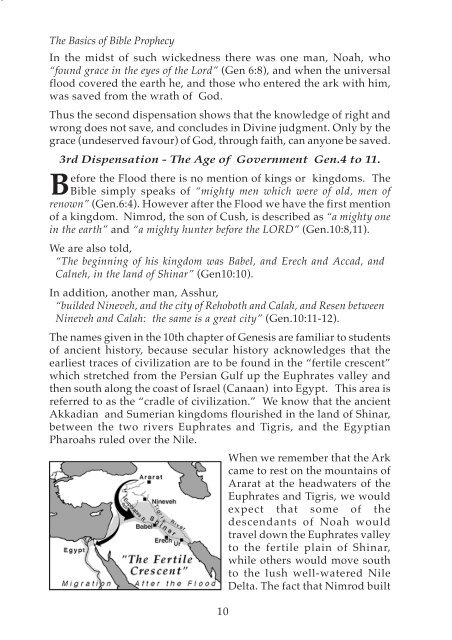The Basics of Bible - Herald of Hope
The Basics of Bible - Herald of Hope
The Basics of Bible - Herald of Hope
Create successful ePaper yourself
Turn your PDF publications into a flip-book with our unique Google optimized e-Paper software.
<strong>The</strong> <strong>Basics</strong> <strong>of</strong> <strong>Bible</strong> Prophecy<br />
In the midst <strong>of</strong> such wickedness there was one man, Noah, who<br />
“found grace in the eyes <strong>of</strong> the Lord” (Gen 6:8), and when the universal<br />
flood covered the earth he, and those who entered the ark with him,<br />
was saved from the wrath <strong>of</strong> God.<br />
Thus the second dispensation shows that the knowledge <strong>of</strong> right and<br />
wrong does not save, and concludes in Divine judgment. Only by the<br />
grace (undeserved favour) <strong>of</strong> God, through faith, can anyone be saved.<br />
3rd Dispensation - <strong>The</strong> Age <strong>of</strong> Government Gen.4 to 11.<br />
Before the Flood there is no mention <strong>of</strong> kings or kingdoms. <strong>The</strong><br />
<strong>Bible</strong> simply speaks <strong>of</strong> “mighty men which were <strong>of</strong> old, men <strong>of</strong><br />
renown” (Gen.6:4). However after the Flood we have the first mention<br />
<strong>of</strong> a kingdom. Nimrod, the son <strong>of</strong> Cush, is described as “a mighty one<br />
in the earth” and “a mighty hunter before the LORD” (Gen.10:8,11).<br />
We are also told,<br />
“<strong>The</strong> beginning <strong>of</strong> his kingdom was Babel, and Erech and Accad, and<br />
Calneh, in the land <strong>of</strong> Shinar” (Gen10:10).<br />
In addition, another man, Asshur,<br />
“builded Nineveh, and the city <strong>of</strong> Rehoboth and Calah, and Resen between<br />
Nineveh and Calah: the same is a great city” (Gen.10:11-12).<br />
<strong>The</strong> names given in the 10th chapter <strong>of</strong> Genesis are familiar to students<br />
<strong>of</strong> ancient history, because secular history acknowledges that the<br />
earliest traces <strong>of</strong> civilization are to be found in the “fertile crescent”<br />
which stretched from the Persian Gulf up the Euphrates valley and<br />
then south along the coast <strong>of</strong> Israel (Canaan) into Egypt. This area is<br />
referred to as the “cradle <strong>of</strong> civilization.” We know that the ancient<br />
Akkadian and Sumerian kingdoms flourished in the land <strong>of</strong> Shinar,<br />
between the two rivers Euphrates and Tigris, and the Egyptian<br />
Pharoahs ruled over the Nile.<br />
When we remember that the Ark<br />
came to rest on the mountains <strong>of</strong><br />
Ararat at the headwaters <strong>of</strong> the<br />
Euphrates and Tigris, we would<br />
expect that some <strong>of</strong> the<br />
descendants <strong>of</strong> Noah would<br />
travel down the Euphrates valley<br />
to the fertile plain <strong>of</strong> Shinar,<br />
while others would move south<br />
to the lush well-watered Nile<br />
Delta. <strong>The</strong> fact that Nimrod built<br />
10


